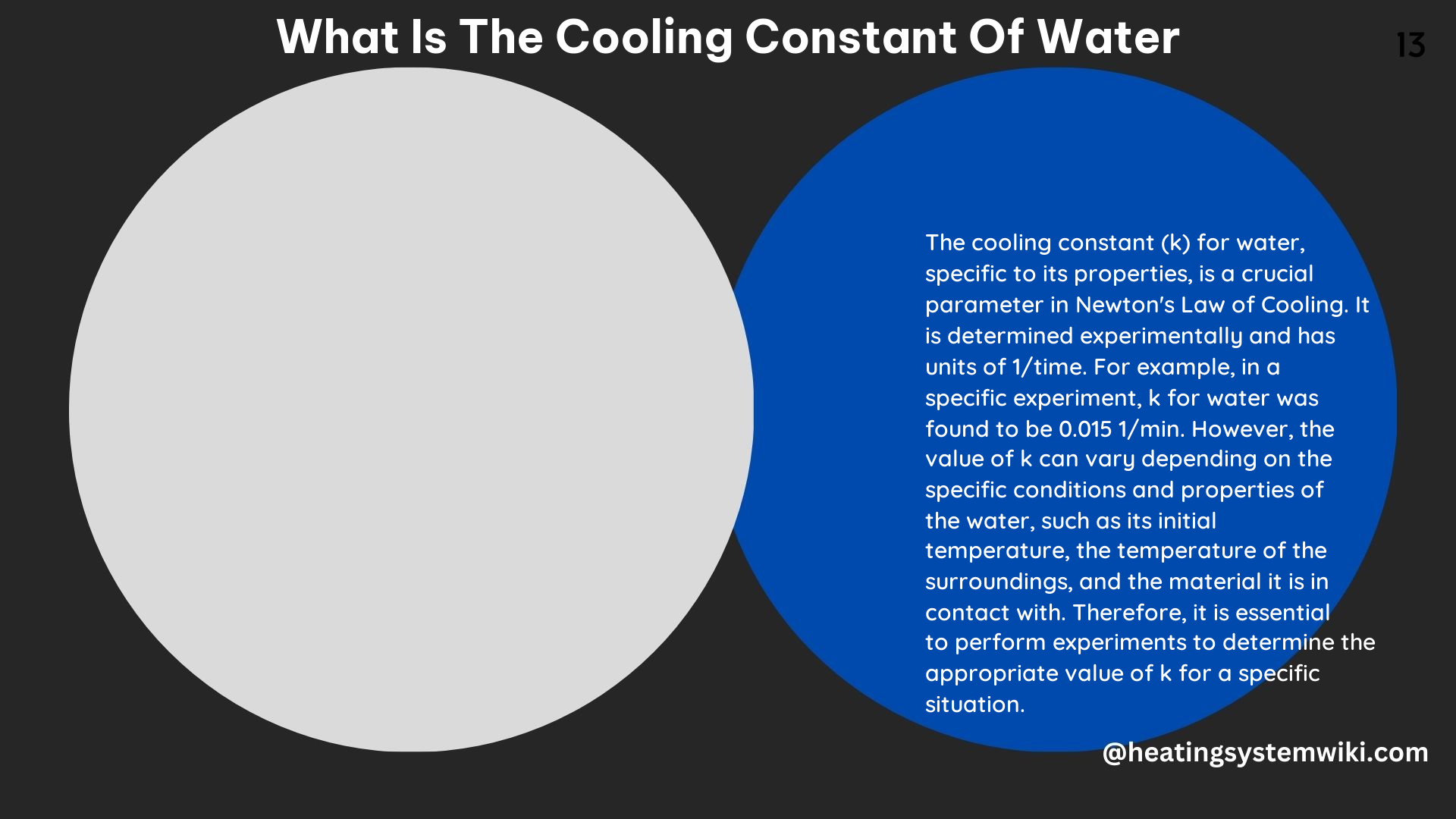The cooling constant of water, denoted by the symbol ‘k’, is a measure of the rate at which water loses heat to its surroundings. It is typically expressed in units of 1/time, such as 1/minute or 1/second, and depends on various factors, including the surface area of the water, the temperature difference between the water and its surroundings, and the properties of the material that the water is in contact with.
Technical Specification of the Cooling Constant of Water
The cooling constant of water can be determined experimentally by measuring the temperature of a container of water over time while keeping the temperature of the surroundings constant. By fitting an exponential curve to the temperature data, the cooling constant can be estimated.
The mathematical expression for the cooling constant is derived from Newton’s law of cooling, which states that the rate of change of the temperature of an object is proportional to the difference between its own temperature and the temperature of its surroundings. This can be expressed as:
dT/dt = -k(T – Ts)
where:
– dT/dt is the rate of change of the temperature of the object
– T is the temperature of the object
– Ts is the temperature of the surroundings
– k is the cooling constant
The value of the cooling constant ‘k’ can vary depending on the specific conditions of the experiment. Some key factors that can affect the cooling constant of water include:
- Surface Area: Increasing the surface area of the water exposed to the surroundings will generally increase the cooling constant, as there is more area for heat transfer to occur.
- Temperature Difference: A larger temperature difference between the water and its surroundings will result in a higher cooling constant, as the driving force for heat transfer is greater.
- Material Properties: The properties of the material that the water is in contact with, such as its thermal conductivity and emissivity, can also influence the cooling constant.
Typical values for the cooling constant of water can range from around 0.02 to 0.05 1/minute, depending on the experimental conditions. For example, in one study, the author estimated the cooling constant of a cup of hot water cooling in a room at 72°F to be approximately 0.0267 1/minute.
DIY for Measuring the Cooling Constant of Water

To measure the cooling constant of water yourself, you can perform a simple experiment using a thermometer, a container of water, and a stopwatch. Here’s a step-by-step guide:
- Fill a container with water and measure its initial temperature using a thermometer.
- Record the temperature of the surroundings (e.g., the room temperature) using a thermometer.
- Stir the water gently to ensure it is at a uniform temperature.
- Start a stopwatch and record the temperature of the water every minute for at least 30 minutes.
- Plot the temperature data on a graph, with time on the x-axis and temperature on the y-axis.
- Fit an exponential curve to the data using a graphing calculator or software.
- The cooling constant can be estimated from the slope of the exponential curve.
It’s important to note that the cooling constant of water can vary depending on several factors, so it’s essential to control these factors as much as possible during the experiment to ensure accurate results. Additionally, use a thermometer with appropriate precision and accuracy for the temperature range of interest, such as a digital thermometer with a resolution of 0.1°C or better.
By following these steps, you can measure the cooling constant of water and gain a better understanding of the rate of heat transfer between water and its surroundings.
References
- GeeksforGeeks. (2021). Newton’s Law of Cooling: Definition, Proof, Formulas, & Examples. Retrieved from https://www.geeksforgeeks.org/newtons-law-of-cooling/
- Physics Forums. (2013). A decent k value for Newton’s law of cooling for water? Retrieved from https://www.physicsforums.com/threads/a-decent-k-value-for-newtons-law-of-cooling-for-water.707572/
- Lowe, L. (n.d.). Cooling Water. Retrieved from https://jwilson.coe.uga.edu/EMAT6680Fa07/Lowe/Assignment%2012/CoolingWater.html
- NYU Engineering. (n.d.). Newton’s Law of Cooling. Retrieved from http://engineering.nyu.edu/gk12/Fellows/Nerik/Labs/lab4-heat%20transfer_nerik.doc
- Soft Schools. (n.d.). Newton’s Law of Cooling Formula. Retrieved from https://www.softschools.com/formulas/physics/newtons_law_of_cooling_formula/93/
